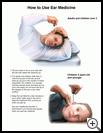
Earwax Buildup
________________________________________________________________________
KEY POINTS
- Earwax is a sticky substance that can build up in your ears.
- Your healthcare provider may remove earwax using an ear wash or small tool. It may also be treated with medicine.
- You can use a few drops of baby oil or mineral oil in the ear, or earwax removal drops to soften the earwax.
- Do not use common objects such as cotton swabs or other items to remove earwax on your own. They may cause harm to your ear.
________________________________________________________________________
What is earwax?
Earwax is a sticky substance made by glands in the outer part of the ear canal. Earwax may be soft or hard or dry and flaky. It can vary in color from white to yellow to brown or black. Earwax helps keep dust, dirt, and other substances from getting into the ear canal and inner ear. Your ears clean themselves by slowly moving earwax and dirt out of the ear canal opening. Earwax also helps protect your ears from infection.
Earwax may be a problem if it builds up and blocks your ear.
What is the cause?
The exact cause of earwax buildup is not always known. Older adults tend to have more problems with earwax than younger adults. You may have more problems if you have coarse wiry hairs in the ears. Hearing aids may act like a dam, preventing the wax from moving out of the ear canal.
Your ear can get blocked with earwax if you use objects, such as a cotton-tipped swab, to clean the ear canal. The object may press the earwax deep into the ear canal and block it.
What are the symptoms?
Symptoms may include:
- Trouble hearing in one or both ears
- Feeling dizzy
- Ringing in one or both ears (tinnitus)
- Itching
How is it treated?
There are safe ways to remove earwax if it is causing discomfort or a loss of hearing. You can use a few small drops of baby oil or mineral oil in the ear, or earwax removal drops to soften the earwax. This may be enough to get extra wax to move slowly out of the ear. The wax will fall out or may be cleaned safely from the outer ear with a washcloth.
Don't try to soften the wax in your ear if you have ear pain or cold symptoms, or if your eardrum has ever had a hole or tear. If you have ear pain, you should see your healthcare provider.
Earwax that is causing problems can be removed by your healthcare provider. Your provider may use ear washes, a tiny spoon-shaped tool, or suction.
Your healthcare provider may refer you to an ear nose and throat specialist for earwax removal if you have:
- Frequent blockages by earwax
- Chronic ear infections
- An eardrum with a tear or hole in it
- Only one ear with good hearing and that ear is the one with the earwax buildup
How can I take care of myself?
Follow the full course of treatment prescribed by your healthcare provider. In addition:
- Never try to remove earwax yourself with objects such as a cotton-tipped swab, pencil, car key, bobby pin, toothpick, matchstick, or high-pressure water spray. These are unsafe tools for removing earwax. They often push the earwax further down the ear canal toward the eardrum. They can hurt the ear canal or make a hole in the eardrum. They may damage the small bones in the middle ear behind the eardrum. They can even damage the inner ear, causing permanent hearing loss.
Ask your provider:
- How and when you will get your test results
- If there are activities you should avoid and when you can return to your normal activities
- How to take care of yourself at home
- What symptoms or problems you should watch for and what to do if you have them
Make sure you know when you should come back for a checkup. Keep all appointments for provider visits or tests.

